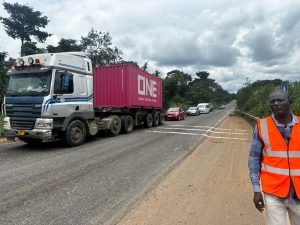In a bold move to reshape Ghana’s infrastructure landscape, President John Mahama recently relaunched the National Infrastructure Plan (NIP), a 30-year blueprint aimed at transforming the country’s economic and social fabric. Anchored on nine strategic pillars—including energy, water, transport, and housing—the plan promises a coordinated and disciplined approach to infrastructure delivery.

This follows a recent announcement of roads which will benefit from the Big Push programme. Very conspicuously absent from the government’s grand vision is the existing Kumasi–Accra highway, a vital artery that connects Ghana’s two largest cities, serves as a lifeline for millions, and literally holds Ghana together, and has been for many years.
A puzzling and deeply concerning omission
The Kumasi–Accra corridor is more than just a road. It is the economic spine of Ghana, linking the political capital with the commercial hub. Every day, tens of thousands of Ghanaians—traders, students, farmers, civil servants—travel this route, many of whom cannot afford the luxury of air travel.
The road is also a key conduit for goods and services, facilitating trade between the north and south, and connecting Ghana to its neighbours through the ECOWAS corridor.
Yet, despite its importance, the road has become a symbol of neglect. Potholes, poor signage, inadequate lighting, and dangerous overtaking lanes have turned it into a death trap. Accidents are frequent and often fatal. The human cost is staggering, and the economic cost—through lost productivity, vehicle damage, and delayed deliveries—is incalculable.
The government’s preference for a new multi-lane expressway may seem visionary, but it risks overlooking a more immediate and cost-effective solution: completing and upgrading the existing Kumasi–Accra highway. This is not an either-or scenario. As seen in many developed countries, multiple high-quality roads can—and should—coexist to serve different segments of the population and economy.
Whilst there has been no categorical statement to say the existing road will not be completed, the lack of a plan for completing it, and the preference for a new multi-lane expressway, as expressed by both the President and the Minister for Roads and Highways, clearly show that the existing road does not feature much in their thinking and p; planning.
The argument that completing the existing road is too expensive does not hold up under scrutiny. While initial estimates for the new expressway may appear lower, Ghana’s infrastructure history suggests that project costs often escalate due to delays, inflation, and scope changes. In contrast, upgrading the existing road is a known quantity. The right-of-way is already secured, the alignment is established, and much of the groundwork has been laid. It is, in many ways, a low-hanging fruit.
Financing upgrades to the existing highway
One of the most compelling ways to finance the completion of the existing road is through a Public-Private Partnership (PPP). This model allows the private sector to design, finance, build, and maintain the road, while recouping its investment through tolls over an agreed period. Crucially, this approach does not add to the government’s debt burden—a key consideration in today’s fiscally constrained environment.
Tolling sections of the road, especially high-traffic zones, can generate steady revenue streams. With proper regulation and transparency, this can be a win-win: the private sector gets a fair return, and the public gets a safer, faster, and more reliable road. If the cost of the project is high, the concession period can simply be extended to ensure viability.Moreover, PPPs bring with them a culture of efficiency and accountability.
Unlike traditional government-led projects, which are often plagued by delays and cost overruns, PPPs are performance-based. The private partner has a vested interest in delivering quality work on time and maintaining the road to high standards.
Fixing the Kumasi–Accra highway would not only save lives and boost economic activity—it would also be a political masterstroke. In an era where infrastructure is increasingly seen as a measure of government competence, delivering a tangible, high-impact project like this could significantly enhance the administration’s image.
The public is watching. Ghanaians are not opposed to new expressways, but they are rightly sceptical of grand promises that ignore pressing realities. The Kumasi–Accra road is a daily pain point for millions. Addressing it would send a powerful message: that the government listens, that it cares, and that it can deliver.
The National Infrastructure Plan rightly seeks to align with the African Union’s Agenda 2063 and the United Nations Sustainable Development Goals (SDGs). But these lofty ambitions must be grounded in practical action. SDG 9, for instance, calls for building resilient infrastructure and fostering innovation. What could be more aligned with this goal than rehabilitating a critical national asset using innovative financing models?
Similarly, the government’s Big Push agenda aims to catalyse economic transformation through infrastructure. Yet, bypassing the Kumasi–Accra road undermines this objective. No infrastructure push can be truly “big” if it ignores the country’s most important transport corridor.
The time to act is now. The government must revisit its priorities and include the Kumasi–Accra highway in its infrastructure agenda. This does not mean abandoning the new expressway project, but rather complementing it with a pragmatic, people-centred approach.Here’s my recommendation of what needs to happen if the repair and upgrade of the existing highway is to become a reality:
- Commission a feasibility study for completing and upgrading the existing road using a PPP model.
- Engage stakeholders, including local communities, transport unions, and private investors, to build consensus and ensure transparency.
- Establish a Value Engineering group of experts to explore alternatives to delivering the most affordable option that presents value-for-money.
- Develop a phased implementation plan, starting with the most dangerous and congested sections.
- Establish a regulatory framework led by the private sector to oversee tolling, maintenance, and service standards.
- Communicate clearly with the public to build trust and manage expectations.
Conclusion
To conclude, let me state that infrastructure is not just about concrete and steel—it’s about people. It’s about connecting communities, enabling commerce, and improving lives. The Kumasi–Accra highway embodies all these values. Ignoring it in favour of a shiny new expressway is not just short-sighted, it is also unjust.It is hoped that the next budget to be presented in the next couple of weeks will take this all-important road into account and provide a plan for its completion. Ghana deserves better. And it starts with fixing the road that connects its heart to its soul.
By Dr Joseph K. Ofori-Kuragu
The Author is a PPP expert based at Anglia Ruskin University, UK. He is a Director at Project Excellence and Innovation, and can be reached via email:joseph.ofori@aru.ac.uk
For more news, join The Chronicle Newspaper channel on WhatsApp: https://whatsapp.com/channel/0029VbBSs55E50UqNPvSOm2z









